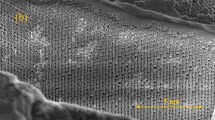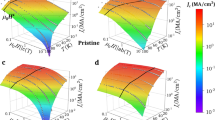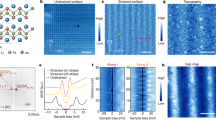Abstract
Boosting large-scale superconductor applications require nanostructured conductors with artificial pinning centres immobilizing quantized vortices at high temperature and magnetic fields. Here we demonstrate a highly effective mechanism of artificial pinning centres in solution-derived high-temperature superconductor nanocomposites through generation of nanostrained regions where Cooper pair formation is suppressed. The nanostrained regions identified from transmission electron microscopy devise a very high concentration of partial dislocations associated with intergrowths generated between the randomly oriented nanodots and the epitaxial YBa2Cu3O7 matrix. Consequently, an outstanding vortex-pinning enhancement correlated to the nanostrain is demonstrated for four types of randomly oriented nanodot, and a unique evolution towards an isotropic vortex-pinning behaviour, even in the effective anisotropy, is achieved as the nanostrain turns isotropic. We suggest a new vortex-pinning mechanism based on the bond-contraction pairing model, where pair formation is quenched under tensile strain, forming new and effective core-pinning regions.
This is a preview of subscription content, access via your institution
Access options
Subscribe to this journal
Receive 12 print issues and online access
$259.00 per year
only $21.58 per issue
Buy this article
- Purchase on Springer Link
- Instant access to full article PDF
Prices may be subject to local taxes which are calculated during checkout






Similar content being viewed by others
References
Campbell, A. M. & Evetts, J. E. Flux vortices and transport currents in type II superconductors. Adv. Phys. 21, 199–428 (1972).
Gutiérrez, J. et al. Strong isotropic flux pinning in solution-derived YBa2Cu3O7−x nanocomposite superconductor films. Nature Mater. 6, 367–373 (2007).
Macmanus-Driscoll, J. L. et al. Strongly enhanced current densities in superconducting coated conductors of YBa2Cu3O7−x+ BaZrO3 . Nature Mater. 3, 439–443 (2004).
Obradors, X. et al. in Comprehensive Nanoscience and Technology (eds Andrews, D., Scholes, G. & Wiederrecht, G.) (Elsevier, 2010).
Matsumoto, K. & Mele, P. Artificial pinning center technology to enhance vortex pinning in YBCO coated conductors. Supercond. Sci. Technol. 23, 014001 (2010).
Foltyn, S. R. et al. Materials science challenges for high-temperature superconducting wire. Nature Mater. 6, 631–642 (2007).
Kang, S. et al. High-performance high- Tc superconducting wires. Science 311, 1911–1914 (2006).
Goyal, A. et al. Irradiation-free, columnar defects comprised of self-assembled nanodots and nanorods resulting in strongly enhanced flux-pinning in YBa2Cu3O7−δ films. Supercond. Sci. Technol. 18, 1533–1538 (2005).
Haugan, T., Barnes, P. N., Wheeler, R., Meisenkothen, F. & Sumption, M. Addition of nanoparticle dispersions to enhance flux pinning of the YBa2Cu3Ox superconductor. Nature 430, 867–870 (2004).
Blatter, G., Feigelman, M. V., Geshkenbein, V. B., Larkin, A. I. & Vinokur, V. M. Vortices in high-temperature superconductors. Rev. Mod. Phys. 66, 1125–1388 (1994).
Teichert, C. Self-organization of nanostructures in semiconductor heteroepitaxy. Phys. Rep. Rev. Sec. Phys. Lett. 365, 335–432 (2002).
MacManus-Driscoll, J. L. Self-assembled heteroepitaxial oxide nanocomposite thin film structures: Designing interface-induced functionality in electronic materials. Adv. Funct. Mater. 20, 2035–2045 (2010).
Mele, P. et al. Ultra-high flux pinning properties of BaMO3-doped YBa2Cu3O7−x thin films (M=Zr, Sn). Supercond. Sci. Technol. 21, 032002 (2008).
Puig, T. et al. Vortex pinning in chemical solution nanostructured YBCO films. Supercond. Sci. Technol. 21, 034008 (2008).
Van der Laan, D. C., Haugan, T. J. & Barnes, P. N. Effect of a compressive uniaxial strain on the critical current density of grain boundaries in superconducting YBa2Cu3O7−δ films. Phys. Rev. Lett. 103, 027005 (2009).
Van der Laan, D. C. et al. Effect of strain, magnetic field and field angle on the critical current density of YBa2Cu3O7−δ coated conductors. Supercond. Sci. Technol. 23, 072001 (2010).
Deutscher, G. & de Gennes, P. G. A spatial interpretation of emerging superconductivity in lightly doped cuprates. C.R. Phys. 8, 937–941 (2007).
Deutscher, G. Origin of weak-link behavior of grain boundaries in superconducting cuprates and pnictides. Appl. Phys. Lett. 96, 122502 (2010).
Birkholz, M. Thin Film Analysis by X-ray Scattering (Wiley–VCH, 2006).
Lutterotti, L. http://www.ing.unitn.it/~maud/.
Abellán, P. et al. Interaction between solution derived BaZrO3 nanodot interfacial templates and YBa2Cu3O7 films leading to enhanced critical currents. Acta Mater. 59, 2075–2082 (2011).
Gutierrez, J. et al. Anisotropic c axis pinning in interfacial self-assembled nanostructured trifluoracetate–YBa2Cu3O7−x films. Appl. Phys. Lett. 94, 172513 (2009).
Gutierrez, J. et al. The role of stacking faults in the critical current density of MOD films through a thickness dependence study. Supercond. Sci. Technol. 22, 015022 (2009).
Holesinger, T. G. et al. Progress in nanoengineered microstructures for tunable high-current, high-temperature superconducting wires. Adv. Mater. 20, 391–407 (2008).
Gibert, M. et al. Self-organized Ce1−xGdxO2−y nanowire networks with very fast coarsening driven by attractive elastic interactions. Small 6, 2716–2724 (2010).
Ramesh, R., Jin, S. & Marsh, P. Superconductor defect structure. Nature 346, 420–420 (1990).
Galindo, P. L. et al. The Peak Pairs algorithm for strain mapping from HRTEM images. Ultramicroscopy 107, 1186–1193 (2007).
Plain, J., Puig, T., Sandiumenge, F., Obradors, X. & Rabier, J. Microstructural influence on critical currents and irreversibility line in melt-textured YBa2Cu3O7−x reannealed at high oxygen pressure. Phys. Rev. B 65, 104526 (2002).
Gutierrez, J., Puig, T. & Obradors, X. Anisotropy and strength of vortex pinning centers in YBa2Cu3O7−x coated conductors. Appl. Phys. Lett. 90, 162514 (2007).
Ando, Y. et al. Resistive upper critical fields and irreversibility lines of optimally doped high- Tc cuprates. Phys. Rev. B 60, 12475–12479 (1999).
Miura, M. et al. Vortex liquid–glass transition up to 60 T in nanoengineered coated conductors grown by metal organic deposition. Appl. Phys. Lett. 96, 072506 (2010).
Welp, U. et al. Effect of uniaxial-stress on the superconducting transition in YBa2Cu3O7 . Phys. Rev. Lett. 69, 2130–2133 (1992).
Chisholm, M. F. & Pennycook, S. J. Structural origin of reduced critical currents at YBa2Cu3O7−δ grain-boundaries. Nature 351, 47–49 (1991).
Ye, J. H. & Nakamura, K. Quantitative structure analyses of YBa2Cu3O7−δ thin-films—determination of oxygen-content from X-ray-diffraction patterns. Phys. Rev. B 48, 7554–7564 (1993).
Klie, R. F. et al. Enhanced current transport at grain boundaries in high- Tc superconductors. Nature 435, 475–478 (2005).
Hilgenkamp, H. & Mannhart, J. Grain boundaries in high- Tc superconductors. Rev. Mod. Phys. 74, 485–549 (2002).
Heinig, N. F., Redwing, R. D., Nordman, J. E. & Larbalestier, D. C. Strong to weak coupling transition in low misorientation angle thin film YBa2Cu3O7−x bicrystals. Phys. Rev. B 60, 1409–1417 (1999).
Obradors, X. et al. Progress towards all-chemical superconducting YBa2Cu3O7 coated conductors. Supercond. Sci. Technol. 19, S1–S14 (2006).
Zalamova, K. et al. Smooth stress relief of trifluoroacetate metal–organic solutions for YBa2Cu3O7 film growth. Chem. Mater. 18, 5897–5906 (2006).
Puig, T. et al. Influence of growth conditions on the microstructure and critical currents of TFA-MOD YBa2Cu3O7 films. Supercond. Sci. Technol. 18, 1141–1150 (2005).
Acknowledgements
The authors would like to thank the Ministerio Ciencia e Innovación (MAT2008-01022), Consolider NANOSELECT (CSD2007-00041), Generalitat de Catalunya (2009 SGR 770 and Xarmae) and the European Union (HIPERCHEM, NESPA and the European Research Council Starting Investigator Award). Work at Oak Ridge National Laboratory was supported by the US Department of Energy, Office of Basic Energy Sciences, Materials Sciences and Engineering Division (M.V.). One of us (G.D.) acknowledges partial support from US Air Force grant FA 8655-10-1-3011. Work at Instituto Nanociencia Aragón—Laboratorio Microscopías Avanzadas was partially supported by NanoAraCat.
Author information
Authors and Affiliations
Contributions
A.L., M.C., R.V., S.Y. and S.R. carried out the synthesis and basic structural characterization of the materials; A.L. and D.C. carried out the advanced analysis of texture and nanostrain of the films through X-ray diffraction; A. Palau, A. Pomar and V.R. made and analysed magnetic and transport measurements; A. Palau, J. Gutiérrez, J.V. and V.M. were in charge of the high-magnetic-field measurements and the corresponding data analysis; J. Gázquez, J.A., R.G., F.S., M.V. and C.M. made different contributions to the TEM observations and the corresponding image analysis and interpretation; G.D. was involved in the theoretical analysis and contributed to the interpretation of the experimental data; A.L. and J. Gázquez wrote parts of the Supplementary Information; T.P. and X.O. designed and supervised the experiments and the theoretical analysis, coordinated the data interpretation and wrote the manuscript. All the authors participated in the correction of the manuscript.
Corresponding author
Ethics declarations
Competing interests
The authors declare no competing financial interests.
Supplementary information
Supplementary Information
Supplementary Information (PDF 2544 kb)
Rights and permissions
About this article
Cite this article
Llordés, A., Palau, A., Gázquez, J. et al. Nanoscale strain-induced pair suppression as a vortex-pinning mechanism in high-temperature superconductors. Nature Mater 11, 329–336 (2012). https://doi.org/10.1038/nmat3247
Received:
Accepted:
Published:
Issue Date:
DOI: https://doi.org/10.1038/nmat3247
This article is cited by
-
Epitaxial growth and high critical current density of BHO-doped YBCO/STO composite films
Journal of Materials Science: Materials in Electronics (2024)
-
Vertical nanoscale strain-induced electronic localization in epitaxial La2/3Sr1/3MnO3 films with ZrO2 nanopillar inclusions
Nano Convergence (2023)
-
Dislocation interactions during plastic relaxation of epitaxial colloidal crystals
Nature Communications (2023)
-
Impact of high growth rates on the microstructure and vortex pinning of high-temperature superconducting coated conductors
Nature Reviews Physics (2023)
-
Development of metal-organic deposition-derived second-generation high-temperature superconductor tapes and artificial flux pinning
Advances in Manufacturing (2023)



